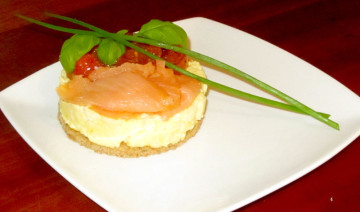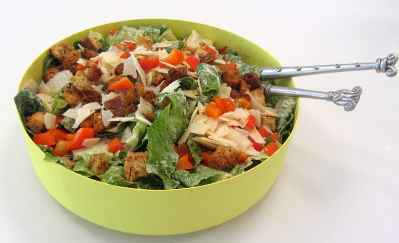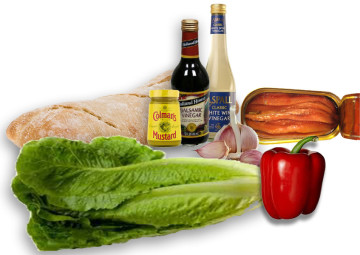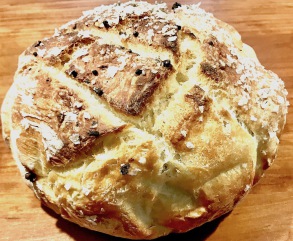
RECIPES
Duncan's Ilsington Scrambled Eggs with a Twist
I was first inspired to develop this simple but very elegant recipe when we stayed at the Ilsington Country House Hotel below Haytor on Dartmoor National Park
in Devon. It was the lovely presentation which struck me.
I hope this photo does it justice.
The hotel has one advantager (at least) on me and that's their gorgeously fresh eggs laid by their own chickens at the back of the hotel - oh! - and plus they smoke their own salmon. Ah well we do our best and we've had nought but praise for this dish so far!
Here's the recipe: For each person you will need –
• 2 eggs
• a dob of butter and a drizzle of olive or vegetable oil
• a slice of toast - fancy bread better than plain, even half an English muffin
• a good teaspoon of crème fraîche
• salt and black pepper to season
• a few tiny toms to bake (20 mins at 200°C) in good olive + a dash or balsamic
• a twist of smoked salmon (see picture)
• a sprig of fresh basil on the tasty toms
• a spinkling of chopped chivesover the salmon
• a couple of chive leaves for appearances sake
Break the eggs into a bowl, dollop in the crème fraîche or soured cream and season - beat and blend the ingredients (but don't overdo it). Using a non slip surfaced pan, melt the butter and oil then pour in the mixture and stir over a moderate flame (or current) with a high temp (silicon) spoon. Oh, you did remember to pop the bread into the toaster didn't you? Oh and 30 minutes before that to slice the cherry tomatoes (or those even lovelier tiny but aubergine shaped little toms you can sometimes get at the supermaket these days) and pop them into an oven-proof dish with a good drizzle of the very best olive oil, a good sprinkle of feshly ground black pepper, a pinch of salt and a splash of balsamic vinegar - no? - of course you remembered.
Stirring continuously it will take less then 3 minutes for your egg mix to thicken. Keep it moist and take off the heat while still not quite cooked - it will keep on cooking while you prepare your plate and you do NOT want it to dry out - the crème fraîche or soured cream will help keep your scrambled eggs moist, light and fluffy - but even this mix can be overcooked.
Take your toasted bread and cut out a circle with a stainless-steel cutting ring (of course you've got one - EVERY kitchen has a choice of sizes) and dollop on top of the toast and into the ring your very nearly cooked scrambled egg. On the top of that you can now add either scrumple of smoked salmon OR spoon on some of those tasty, now caramelised, toms in their heavenly oil. Or - as I have done here - go half and half. Or serve with salmon on top and tomatoes alongside.
Garnish with basil and chives and serve immediately.
This even looks (and tastes) wonderful served on a larger plate with a complete collection of "Full English" ingredients of sausage, bacon, fried bread and mushrooms (and even black pudding and beans if your guests insist).
Hail Caesar - Emperor of Salads - with Duncan's Dressing
CONTRARY to popular belief, Caesar salad has nothing to do with the various emperors Caesar or Caesar's Palace in Las Vegas.
The Caesar in question was Caesar Cardini, [almost certainly then spelled César but you can’t trust much American history] an Italian emigrant to Mexico. He composed the salad one Fourth of July in
1928 when a party of Americans visited his restaurant in Tijuana. They wanted something new and exciting with which to celebrate their national holiday. (You bet they did. Have you ever tried Mexican
food in Mexico? In Tijuana even?). They returned to Los Angeles with the recipe and from there it conquered America and the salad-eating world. In its subsequent popularity boom Caesar has developed
from starter, to main course and even side salad. There is no hidden agenda; it relies on a simple combination of ingredients. But while many chefs claim to use Cardini's recipe, there are many
variations and it is never quite the same from one place to the next.
I have researched half of California in search of the perfect Caesar (well, more than four dozen eateries in some of the more likely places) and many restaurants in London and Europe and around the
world from Chile to China, from Brazil to Barcelona. I haven’t found perfection yet but I have appreciated to a greater or lesser degree some of the concoctions that have traded under the
Caesar name. I have to say though, that what I like least is the “better not offend anyone” belief of some middle-of-the-road restaurateurs, who omit key ingredients such as anchovies (or even garlic
for goodness sake!) in the vain hope that this blander product will have broader appeal. It completely defeats the object — like leaving the sausage out of toad in the hole, or the chili out of the
“con carne”. If people want César they shouldn’t be passed off with a bland mayonnaise.
So what’s the secret?
I have no idea whether the inventor used such leaves or could even find them in Mexico but to my mind the first essential is Sweet Romaine lettuce (or Cos). Don’t even think about iceberg which is
totally tasteless and fit only for rabbits and grasping market gardeners of a philistine bent.
The real secret is in the dressing. The essentials are simple: garlic, anchovies, olive oil, vinegar (the best balsamic for its nutty sweetness
and/or white wine venegar and a raw egg-yolks. I also tip in a teaspoon of mustard for extra zest.
How these ingredients are combined is the greatest variable amongst all those salads I have sampled. Some leave the anchovies in strips (I suspect to make it easy for their customers to leave to one
side). Others add hard-boiled eggs (to reduce the risk of salmonella - but how can you find paradise without risk?). And my preferred way of combining these powerfully flavoured ingredients is to
whiz them together with a hand-held blender-wand in a narrow jug. The result in a thick, thick mayonaise dressing which spreads the flavour evenly throughout the salad and clings resolutely to the
leaves like garlic to your breath after a good Caesar.
The next key ingredient is the crouton. There is only one real crouton. And that is made fresh from cubes of good ciabata bread. My favourite
croutons are oven baked with lashings of olive oil, salt and pepper and sometimes parmesan. A good Caesar does NOT belong on your basic slimming diet.
The last ingredient is parmesan cheese in shaven quantity. The better the quality, the better the salad — and a good parmigiano regionale is multo
expensivo. To get the best and most flavoursome effect on the taste-buds there is only one way to render this paragon of cheeses. You have to shave it over the assembled Caesar (those little
Scandinavian cheese slicers are perfect).
For summer I add a good handful of fresh basil and/or a lesser quantity of coriander and the juice and zest of a whole fresh lime and/or lemon. Yummy.
Though a good plate of Caesar is a solid meal in itself, this is a salad that can also provide a platform for more substantial versions. Try adding lobster, smoked oyster, prawns, saucisson sec,
pepperoni, crispy bacon, smoked or tandoori chicken and one of my favorites, prawns gently fried with tandoori spice and a dollop of Greek yogurt. Stronger flavours survive better against the
inherent Caesar tang. These admixtures are not for the purist. On the other hand, those of us addicts, us real Césarists, are happy enough to eat Caesar with almost anything.
As someone said we come in praise of the Caesar not to bury it.
Duncan’s Classic Caesar Recipe
For a basic Caesar try the following mix. You need to experiment with the quantities to find one that suits your own palette, but this is a reasonable start.
Start with all the ingredients that will help homogenise your olive oil and egg yolk into a mayonnaise. That will be the egg yolk(s) the mustard, the garlic and the anchovies. Wizz them together with
a hand blender in a narrow jug and gradually trickle in the olive oil. When it’s nice and gloopy add the balsamic vinegar [and/or white wine vinegar] - and then any other extra variants e.g. lemon or
lime juice, fresh basil and /or coriander.
The following is for about four people.
The Sauce
• 2 medium/large fresh egg yolks.
• 2 or 3 cloves of garlic - a hallmark flavour. It’s important to put as much garlic in as you can get away with. Too much and it tastes bad and you’ll be reeking of garlic
next day. But too little and why bother with Caesar. It’s just another risk you have to take!!
• A tin of anchovies (Swedish ones are OK but I use regular anchovy strips you get in those small ring-pull peel-back tins. Definitely add in all the flavoursome oil from the
tin. The anchovy is a vital ingredient as it is this meat which not only gives it the “tang” but helps homogenise the sauce.)
• A spoonful of ENGLISH mustard (yes I know this is a Yanky recipe – but you want the BEST?]
• A quantity of virgin olive oil, thick and green (about half a cup).
These days I often lighten it 50/50 with light olive oil or even rapseseed or sunflowers oil
• About 1/3 to half as much balsamic vinegar, nutty and sweet [but do also try white wine vinegar].
• A little salt and pepper (remember the anchovies are very salty)
With these ingredients blended you have the core product. But I usually add lemon or lime, basil and/ or coriander.
The Croutons
Slice a ciabata loaf into cubes (about 10-20mm cubed). Scatter on a baking tray in a high oven about 200 °C. Drizzle with good olive oil sprinkle on salt and loads of black pepper. Bake until golden
brown light and crunchy. Take them out and shake them a couple of time or they’ll be black on the top and soft underneath. That’s it.
The Lettuce
You need about half a Romaine lettuce per person but that depends on the size of the Romaine, whether it's a starter or main course and, of course, on the enthusiasm of your guests. I just slice the
whole lettuce into strips about an inch wide (and then rinse - you don't have to dry the leaves thoroughly but I use one of those salad spinners which spins out most of the excess).
The Parmesan
Best Parmigiano Regionale you can afford. Shave it onto the salad as just as it’s being dished up or let guests shave their own.
The Presentation.
Serve in a big wide bowl. At the very last moment before dishing up pour the sauce over the salad and mix thoroughly. This is a salad which MUST be served freshly mixed, though you can make the sauce
an hour or two ahead and keep it covered with clingfilm. Next pour over the croutons and add any of the optional extras (see below). And maybe shave on the parmesan – or leave this to the
guests.
Also looks really cool if you serve this in a shallow glass bowl lined with washed whole Romaine leaves – but first mix up the chopped salad in another bowl obviously.
Optional extras:
• Almost invariably these days I add lightly fried red pepper (capsicum), sliced and cut into small cubes. Adds texture, vitamin C and a touch of nice contrasting
colour
• As mentioned, lobster, prawns, chicken (which can be tandooried or otherwise flavoured), dried sausage, pepperoni, chorizo, crispy bacon, smoked oysters.
Good luck! Enjoy.
-----------------------------------------------------------------------------------------------------------------------
NO-KNEAD BREAD
The simplest ever bread recipe
This is just about the simplest kind of bread you can make. You basically throw everything into a bowl and mix it up, then sit around, let the yeast do its work, and bake it.
No-knead bread gets its power from a long, slow rise at room temperature.
Once out of the oven, let the bread cool for 15 minutes before slicing and serving.
Any bread not slathered in butter and devoured immediately should be tightly wrapped and stored at room temperature where it keeps well for about three days. After that? Cut it into cubes for the best croutons of your life.
Ingredients - makes 1 loaf
• 1 pound (= 0.45Kg) all-purpose flour (3 American cups)
• 2 teaspoons salt
• 3/4 (three quarters) teaspoon of dry yeast
• 1 1/2 cups lukewarm water
• Cling-film and / or kitchen towel
• Large cast-iron Dutch oven/casserole pot with oven-proof lid
• Parchment / greaseproof paper
Instructions:
1. Shaggy dough. Place the flour, salt, and yeast in a large bowl and whisk to combine. Make a well in the centre,
add the water into the well. Stir with a wooden spoon until it forms a shaggy dough.
2. Let the dough rise for 6 to 8 hours (or overnight). Cover the bowl with Cling-film or a kitchen towel. Set aside
in a warm place to rise until doubled in size and bubbly.
3. Shape the dough. Lightly flour a piece of parchment/greaseproof paper. Turn the dough out onto it, folding it
over on itself at least once while you do so. Quickly shape the dough into a round ball. Cover with Clingfilm and/or kitchen towel and let it rise for 1 hour more.
4. Heat up the oven. About 30 minutes before the hours is up heat the oven to 450°F (230°C) with the cast-iron pot
and lid on a middle shelf
5. Transfer to oven. The shaped dough will have risen and nearly doubled in size. Using the paper as a sling,
carefully transfer the loaf with the paper into the cast-iron pot. Make a slash cut on the top of the dough with a sharp knife so that the bread can expand while baking.
An option here (we do it ) - is to sprinkle or spray a little water over the top which will make it extra crusty and scatter some large grained sea-salt over the top. Also try adding cumin or sesame
seeds for more flavourful yummyness.
6. Cover and bake. Place the lid on the pot and put it in the oven. (Careful, the lid is hot!)
Bake covered for 30 minutes.
Another option: After much practice, instead of the round metal casserole/Dutch oven I drop the dough, still on
the paer, into a regular non-stick bread pan, proceed as above and find something suitable to cover it with for the first 1/2 hour.
7. Remove the lid and bake for a further 15 minutes more or until it looks just right.
8. Cool and slice the bread. Remove the pot from the oven and use the paper to transfer the bread to a wire rack.
Let it cool for 15 minutes before slicing. Nowadays I use an electric slicing machine – works a treat and you can slice quite thinly.
Storage: Store cut-side down at room temperature for up to 3 days.
Or wrapped and frozen for up to 3 months.
Good luck! Enjoy.
-----------------------------------------------------------------------------------------------------------------------
HOME I YOUR HOSTS I BEDROOMS I
OTHER ROOMS I HOUSE FACILITIES I LOCAL AMENITIES
LONDON SIGHTSEEING I LOCATION-TRANSPORT I MENU-RECIPES
CONTACT-AVAILABILITY-ENQUIRIES





